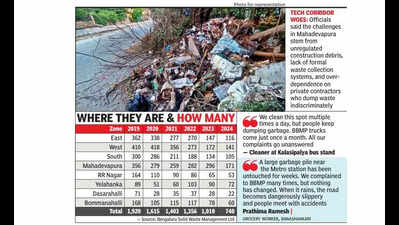Bengaluru’s black spots down 60% in 6 years, but Mahadevapura faces hurdles | Bengaluru News

Bengaluru: The city has seen a remarkable reduction in the number of black spots over the past few years, reflecting a steady improvement in sanitation and waste management practices.
According to Bengaluru Solid Waste Management Ltd (BSWML) data accessed by TOI, the number of black spots recorded and cleared daily across the city dropped from 1,920 in 2019 to 740 in 2024. The decline was consistent year after year, barring a few fluctuations, and represents a significant turnaround in Bengaluru’s efforts to tackle chronic garbage-dumping zones.
In 2020, the number of black spots fell to 1,615, marking a 16% decrease from the previous year. The downward trend continued in 2021, with 1,403 black spots recorded, a further 13% reduction. In 2022, the number fell marginally to 1,356, down 3.4%. However, a sharper decline followed in 2023, when the number dropped 25% to 1,010. In 2024, the city reported 740 black spots, which translates to a 27% drop from 2023. Though the data for 2024 is only partial, if the trend continues, the annual total could fall well below the 1,000 mark for the first time since records began. As per BSWML, in April 2025, the number of black spots in Bengaluru is 520.
The data spans 27 divisions spread over eight zones, and most zones have shown significant improvement over time. East zone, which includes divisions such as Hebbal, Shivajinagar, and Shanthinagar, has brought down its black spot count from 362 in 2019 to 116 in 2024. “It’s the constant monitoring by marshals and the conscious efforts by BSWML to monitor waste management that has led to a decrease in black spots,” said a senior BSWML official.
South zone has shown a similar improvement, with the count falling from 300 to 105 over the same period. Dasarahalli, though a smaller zone, recorded one of the steepest declines — from 71 in 2019 to just 22 in 2024, a 69% reduction. “The challenges in Dasarahalli are the market and the population. People were more ignorant about black spots, but they are getting more aware and trying not to dump waste on empty sites. If the residents become more conscious, controlling the eateries and restaurants is easy for us,” added the official.
West Bengaluru too has recorded a sharp drop, from 410 black spots in 2019 to 141 in 2024, with Gandhinagar, Govindarajanagar, and Rajajinagar showing sustained improvement. Bommanahalli, which once had among the highest black spot counts in the city, brought down its tally from 168 to 60 during the same period.
The outlier in the data is Mahadevapura zone, which showed a worrying upward trend till last year. While other zones saw steady declines, Mahadevapura recorded a spike in 2023 with 296 black spots — its highest since 2019 — before sharply reducing to 171 in 2024. KR Pura and Mahadevapura divisions under this zone consistently registered high numbers, reflecting the civic stress faced by areas with rapid urbanisation and infrastructural lag. According to BSWML officials, the challenges in Mahadevapura stem from unregulated construction debris, lack of formal waste collection systems in tech corridors, and over-dependence on private contractors who often dump waste illegally.
Despite this, the overall citywide trend remains encouraging. Civic officials credit the improvement to increased surveillance by marshals, introduction of ward-level monitoring, and effectiveness of citizen reporting tools such as BBMP Sahaaya. “Penalties for dumping, awareness campaigns, and greater coordination with contractors have also played a role,” said Harish Kumar, managing director of BSWML.
















